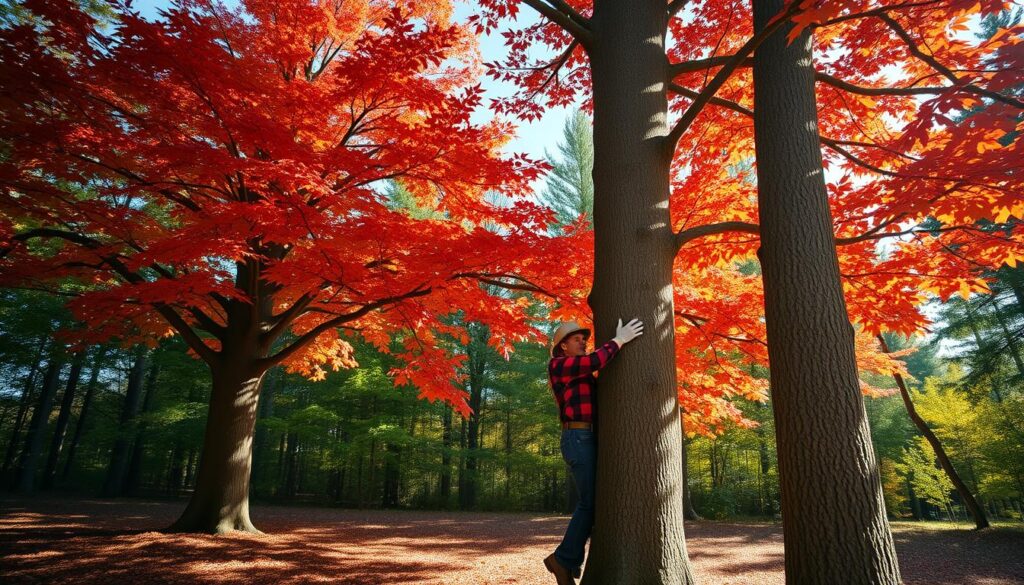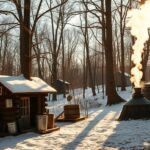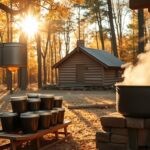Maple syrup is a natural treasure that turns tree sap into a golden, sweet treat. It starts in North America’s forests, where special maple trees make it possible. Learning about maple syrup’s origins shows us how old traditions meet new ways of making it.
The journey from maple tree to syrup is amazing. It needs the right weather and the right trees. Sugarmakers pick the best trees, mainly in the northeastern U.S. and southeastern Canada. Their skill makes the syrup’s quality and taste perfect.
Indigenous communities first found out how to get sap from maple trees. They made ways to collect and use this sweetener before Europeans came. Today, making maple syrup keeps these old ways alive while using new tech.
Wondering where maple syrup comes from? It’s from maple trees, like sugar maples, which give the best sap. Tapping trees, collecting sap, and boiling it down makes the syrup we love. It’s a key part of many breakfasts and fancy recipes.
Every drop of maple syrup tells a story of nature and human skill. It shows the beauty of North America’s forests and the hard work of sugarmakers. Maple syrup is more than a sweetener; it’s a tribute to tradition, craftsmanship, and nature’s gifts.
The Origins of Maple Syrup: Native American Discovery
The tale of maple syrup starts with the indigenous peoples of North America. They found the sweet treasure of maple trees long before Europeans came. Native American communities were the first to master making maple syrup, creating detailed methods for tapping and boiling sap.
Indigenous Peoples’ Traditional Harvesting Methods
Native Americans had clever ways to get maple sap before modern tools. They used:
- Cutting V-shaped incisions in maple tree bark
- Using hollowed-out wooden tubes to drain sap
- Collecting sap in birch bark containers
- Boiling sap by dropping hot stones into wooden vessels
“The maple tree was sacred to many indigenous communities, providing not just food but a vital economic resource.” – Indigenous Cultural Historian
Cultural Significance in Native American Communities
Maple syrup was more than food for Native American tribes. It was a deep connection to nature and the seasons. Maple Syrup Origins were tied to spiritual and practical traditions. Each tribe had its own way of harvesting and rituals.
Early Trading with European Settlers
When Europeans arrived, Native Americans shared their Maple Syrup Facts and how to harvest it. This exchange brought new tools and grew maple syrup’s market.
| Native American Technique | European Adaptation |
|---|---|
| Wooden taps | Metal spouts |
| Stone boiling | Large metal evaporation pans |
| Birch bark containers | Wooden buckets |
Understanding Maple Trees: The Source of Sweet Sap
Maple trees are nature’s sugar factories. They play a key role in making maple syrup. Found mainly in North American forests, these trees have special traits for sap extraction.
Maple trees have unique anatomy for sap production. Species like sugar maple, black maple, and red maple have special structures. These allow sap to move with temperature changes. Maple Syrup Explained shows that these trees store starch in their roots and trunks. This starch turns to sugar in spring.
- Maple trees need specific climate conditions
- Trees must be mature (typically 40+ years old)
- Minimum trunk diameter of 10 inches recommended
Sap production relies on many environmental factors. Temperature changes between cold nights and warm days create pressure. This pressure makes maple sap flow. Sugarmakers know how to harness this process to make syrup.
The magic starts deep in the tree’s cells. Specialized cells called xylem and phloem move nutrients and water. This creates the right conditions for sap extraction. Knowing these natural processes helps us value every drop of maple syrup.
Different Types of Maple Trees Used for Syrup Production
Maple Syrup Production depends on certain maple tree types. These trees have special qualities and sap that make syrup. Knowing the different maple tree species helps sugarmakers pick the best trees for sap collection.
Many maple tree species are important for syrup making. Each tree has its own special qualities. The best trees have lots of sugar and a strong flavor, making great maple syrup.
Sugar Maple Trees
Sugar maple trees are the top choice for syrup. Acer saccharum is the best for syrup makers. These trees have:
- More sugar in their sap
- A lighter, sweeter syrup flavor
- The best sap flow in early spring
Black Maple Trees
Black maple trees are similar to sugar maples. They are found in the same places and give good sap for syrup.
| Maple Tree Type | Sugar Content | Geographical Distribution |
|---|---|---|
| Sugar Maple | 2-5% sugar content | Northeastern United States |
| Black Maple | 2-4% sugar content | Midwest and Northeast regions |
Red Maple Trees
Red maple trees are another choice for syrup. They have less sugar in their sap. But, they are useful when sugar maples are scarce.
- Less sugar in sap
- Sap flows earlier in spring
- Found all over North America
Picking the right maple tree is key for making great syrup. Sugarmakers look at tree traits to get the best syrup and flavor.
The Science Behind Maple Sap Flow
Maple Syrup Explained is all about the amazing journey of maple tree sap. It’s a mix of temperature, pressure, and biology that turns tree sap into sweet syrup.
The journey starts with special temperature conditions. In winter, maple trees store starches in their roots and trunk. When day temperatures rise and night temperatures drop, the tree’s system changes.
- Daytime warmth creates positive pressure inside the tree
- Nighttime cold generates negative pressure
- These pressure changes force sap to move through the tree’s tissues
Maple Tree Sap flows through special tissues called xylem and phloem. These paths carry nutrients and water. When temperatures change, the sap moves due to pressure differences.
Sugarmakers know how to tap into this flow. They wait for the right weather – usually early spring when days are cool and nights are cold.
Nature’s own pump creates the remarkable journey of maple sap from tree roots to collection buckets.
This process shows how maple trees adapt to temperature changes. It’s a natural wonder that has amazed people for centuries.
Where Does Maple Syrup Come From: The Complete Process
The journey of maple syrup is amazing. It turns raw tree sap into a tasty golden liquid. From the forests of North America to your kitchen, it’s a mix of nature and human skill.
The story starts with picking the right trees and tapping them at the right time. Sugarmakers choose mature trees that make the most sap.
From Tree to Table Journey
The maple syrup process has key steps:
- Tree identification and selection
- Tapping maple trees during late winter
- Collecting raw sap using specialized equipment
- Transporting sap to processing facilities
- Boiling and reducing sap to create syrup
Modern Production Methods
Today’s maple syrup making is much better. New tech helps collect and process sap faster. Vacuum systems and thermal sensors make syrup production more efficient.
Traditional vs Contemporary Techniques
Even with new tech, many stick to old ways. Wooden buckets and wood-fired evaporators keep traditions alive. They connect today’s makers with the past.
“Maple syrup production is an art form that bridges nature’s complexity with human ingenuity.” – Maple Syrup Artisan
Every drop of maple syrup shows the amazing change from sap to sweet syrup. It shows how humans and nature work together.
Optimal Climate Conditions for Maple Syrup Production
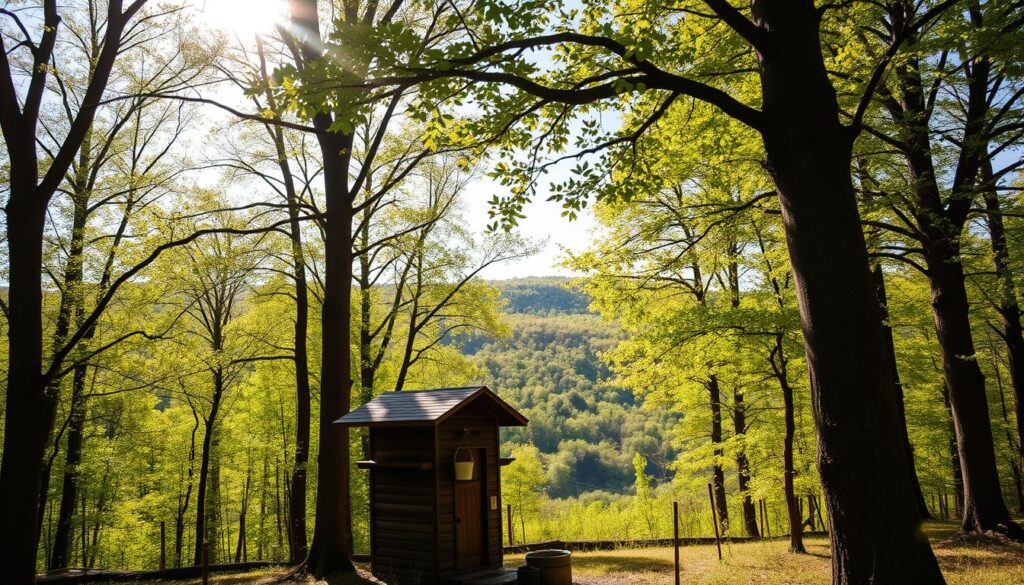
Maple syrup production needs specific climate conditions for sap flow. The northeastern parts of North America are perfect for this. They offer the right environment for this unique farming practice.
The magic of making maple syrup happens when winter turns to spring. Sugarmakers need the right temperature changes. These changes make maple trees’ sap move exceptionally well.
- Daytime temperatures must rise above 40°F (4°C)
- Nighttime temperatures should drop below 32°F (0°C)
- These changes create pressure inside maple trees
Maple Syrup Facts show that these temperature changes are key for sap extraction. When the ground freezes and thaws, it pushes sap up through the tree. This is because of the pressure inside the tree.
Places with consistent winter-to-spring changes are best for maple syrup. States like Vermont, New Hampshire, and parts of Canada have these conditions.
Elevation and forest density also matter for maple syrup production. Forests with mature maple trees at moderate elevations give the best sap yields.
“Nature dictates the rhythm of maple syrup production through its delicate temperature dance.” – Traditional Sugarmaker Wisdom
The Maple Syrup Season: When Nature Dictates
Maple Syrup Harvesting is a dance led by nature’s exact rules. The maple syrup season is a short time when the right temperature conditions make sap flow in maple trees.
For Maple Syrup Production, day and night temperatures are key. The best time is when days are just above freezing (around 40-45°F) and nights are below (around 20-30°F).
Perfect Temperature Conditions
During the maple syrup season, trees go through special pressure changes. These changes make sap move. The pressure from temperature changes helps sap flow, making harvesting possible.
- Daytime temperatures above 40°F
- Nighttime temperatures below 32°F
- Consistent freeze-thaw cycles
Seasonal Timing Variations
The maple syrup season usually lasts 4-6 weeks, from late February to early April. Climate change and weather patterns affect when sap can be collected.
Sugarmakers must watch the weather and tree health closely. This way, they can make the most of their Maple Syrup Production time. Each year brings new challenges, making the harvest both an art and a science.
Modern Maple Syrup Harvesting Equipment
The way we make maple syrup has changed a lot in recent years. New tools have made it easier and faster to get sap from trees. This has made sugarmaking more efficient and productive.
New tech has replaced old ways of getting sap. Some big changes include:
- Plastic tubing networks connecting many maple trees
- Vacuum pump systems for better sap extraction
- Reverse osmosis machines that concentrate sap fast
- Digital systems tracking tree health and sap flow
Vacuum-assisted sap collection is a big step forward. It uses negative pressure to get more sap. Sugarmakers can now get 3-4 times more sap than before.
Modern tech lets us watch maple trees closely. Sensors track:
- Temperature changes
- Sap flow rates
- Tree health signs
- Environmental conditions
Maple syrup making has changed from hard work to a high-tech field. These new tools help make better syrup while keeping the traditional feel alive.
The Boiling Process: Transforming Sap to Syrup
Maple syrup production hits its peak in the boiling stage. This stage turns raw maple sap into the golden syrup we all love. It needs precision, skill, and a deep understanding of heat and sugar.
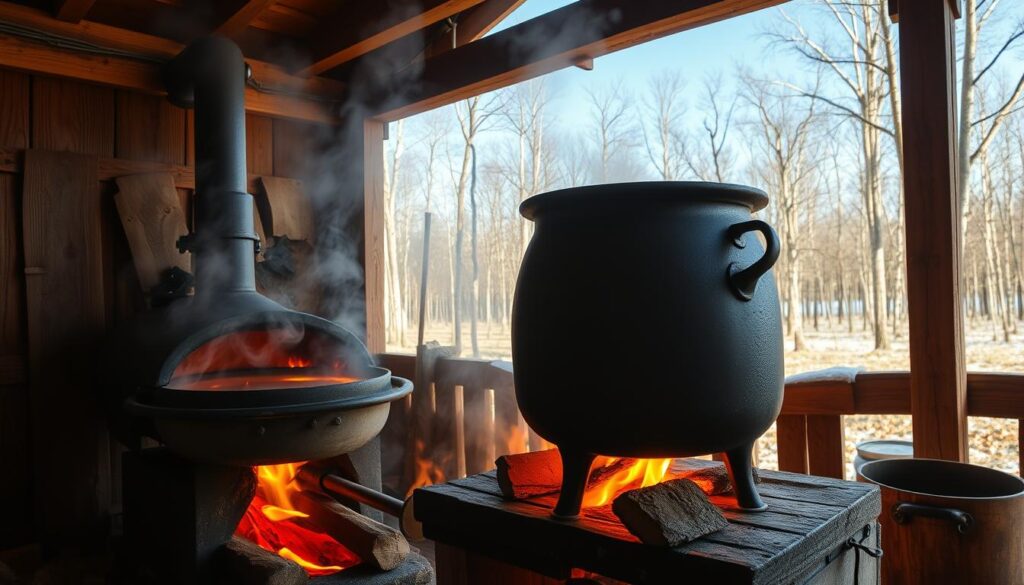
Sugarmakers watch closely as maple sap changes. They use special techniques to remove water and concentrate sugars. These methods have been perfected over many years.
Sugar House Operations
In the sugar house, big evaporators are key. They heat the sap, letting water evaporate slowly. This is where the magic happens.
- Temperatures are kept between 219-221 degrees Fahrenheit
- Stirring constantly prevents burning and ensures even heating
- Experts use hydrometers to check sugar content
Evaporation Techniques
The way sap is evaporated affects syrup quality and taste. Modern sugar houses use advanced gear. This gear keeps the syrup’s authentic flavor while making the process smoother.
- Reverse osmosis pre-concentrates sap
- Efficient wood-fired or oil-powered evaporators
- Precise temperature control systems
Each drop of syrup is a result of hours of careful work. It turns simple tree sap into a delicious natural sweetener through a detailed boiling process.
Grading and Classification of Maple Syrup
Maple Syrup Facts show a detailed grading system. It captures the essence of this natural sweetener. The process highlights the unique qualities of different maple syrup varieties.
The grading system reflects the syrup’s color, flavor, and light transmission. Sugarmakers categorize their product with care. They ensure quality and meet consumer preferences.
- Grade A Light Amber (Golden Color): Delicate flavor, ideal for those seeking a mild taste
- Grade A Medium Amber (Amber Color): Slightly stronger maple flavor
- Grade A Dark Amber (Dark Color): Rich, robust maple taste
- Grade B (Very Dark Color): Strongest, most intense maple flavor
| Grade | Color | Flavor Intensity | Best Used For |
|---|---|---|---|
| Golden | Very Light | Delicate | Dessert toppings, baking |
| Amber | Light to Medium | Moderate | Pancakes, general cooking |
| Dark | Deep Amber | Strong | Cooking, marinades |
| Very Dark | Darkest | Most Intense | Baking, sauces |
The grading process measures light transmittance through the syrup. Lighter grades let more light through. Darker grades let less light through. This ensures consistent quality in maple syrup production.
Professional sugarmakers take pride in producing maple syrup that meets rigorous grading standards. They celebrate the natural complexity of this beloved sweetener.
Major Maple Syrup Producing Regions
Two main areas lead in maple syrup production: the northeastern United States and southeastern Canada. These places have the right geography for making maple syrup.
North America is the top maple syrup producer worldwide. Certain areas are key in making this sweet treat. The right climate, soil, and trees are all important for great syrup.
Vermont: A Maple Syrup Powerhouse
Vermont is a top maple syrup producer in the U.S. It makes about 2 million gallons every year. This makes Vermont a big player in the maple syrup world.
- Ranks first in U.S. maple syrup production
- Features over 1,500 maple syrup producers
- Generates significant agricultural revenue through maple products
Canadian Production Zones
Canada, mainly Quebec, leads in maple syrup production. Quebec makes about 70% of the world’s maple syrup. This makes it a big economic force in the sweetener world.
- Quebec produces over 90% of Canadian maple syrup
- Contains strategic maple forests spanning thousands of acres
- Implements sophisticated harvesting and production techniques
Both regions focus on making maple syrup in a sustainable way. They want to keep this tradition alive for future generations.
Sustainability in Maple Syrup Production
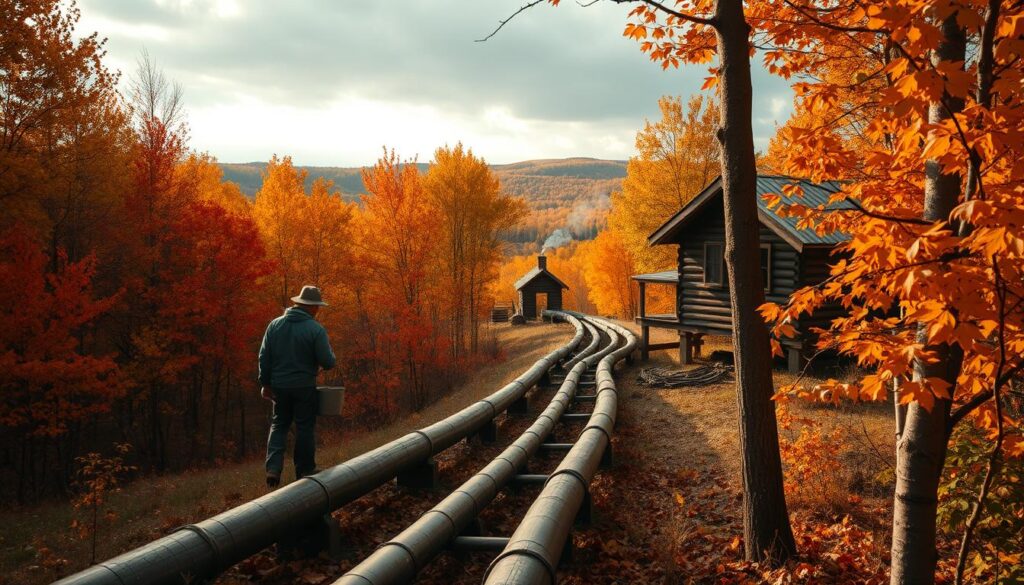
Maple syrup production is a blend of caring for the environment and keeping traditional farming alive. It’s important to use sustainable methods to protect maple forests. This ensures the syrup can be enjoyed for years to come.
Forest care is key in making maple syrup responsibly. Sugarmakers use careful methods to keep maple trees and forests healthy. They do this by:
- Selective tapping techniques that minimize tree stress
- Limiting the number of taps per tree
- Implementing regenerative forest management practices
- Protecting surrounding woodland ecosystems
The effects of maple syrup making go beyond just the trees. Maple Syrup Facts show it helps the environment by storing carbon and keeping wildlife homes safe. Today’s sugarmakers work with nature experts to find ways to make syrup and protect the planet.
Climate change is a big problem for maple syrup makers. Changes in weather can mess up when sap flows. New tech and tracking systems help them keep up with forest health and adjust their syrup making.
When you buy maple syrup, you can help the environment. Look for syrup from producers who care about the planet. This way, you support keeping maple forests safe and traditional farming alive.
Health Benefits and Nutritional Value
Maple syrup is more than a sweetener. It’s packed with nutrients that offer surprising health benefits. Knowing its nutritional profile helps us make better food choices.
Maple Syrup Explained shows it’s not just empty calories. It has a lot of minerals and compounds that are good for us. This makes it different from refined sugars.
Natural Minerals and Antioxidants
Maple syrup gives us important nutrients for health:
- Zinc: Supports immune function
- Manganese: Promotes bone health
- Calcium: Strengthens bones and teeth
- Potassium: Regulates heart and muscle function
Maple syrup has antioxidants like some fruits and veggies. Polyphenols in it fight cell damage and reduce inflammation.
Comparison with Other Sweeteners
Maple syrup is better than other sweeteners for nutrition:
| Sweetener | Mineral Content | Antioxidant Level |
|---|---|---|
| Maple Syrup | High | Significant |
| White Sugar | None | Minimal |
| Honey | Low | Moderate |
Even though maple syrup is sweet, it’s a better choice than refined sugars. It’s more nutritious.
Storage and Preservation Methods
Knowing how to store maple syrup is key to keeping its flavor and quality. Maple Syrup Facts show that the right storage can make the syrup last longer and taste better.
Maple Syrup Explained through storage methods involves a few important steps. The main goal is to keep the syrup clean and its flavor from changing.
- Store unopened maple syrup in a cool, dark pantry
- Refrigerate after opening to prevent spoilage
- Use airtight containers to prevent moisture exposure
- Check for signs of mold or fermentation regularly
Temperature is very important for maple syrup storage. Unopened syrup can stay good at room temperature. But once opened, it needs to be refrigerated. Sugarmakers say to keep it between 32-40°F for the best quality.
Freezing is a popular way to store maple syrup for a long time. It can last up to a year without losing its flavor. Just put the syrup in a freezer-safe container, leaving room for it to expand.
“Proper storage is the secret to enjoying maple syrup at its absolute best.” – Maple Syrup Preservation Expert
It’s important to check your maple syrup often. Look for any changes in color, texture, or smell. If it looks or smells off, it’s best to throw it away for safety.
Conclusion
Maple syrup has a fascinating history in North America. It comes from a natural process that combines ancient knowledge with modern farming. Native American communities first found out how to turn tree sap into a sweet syrup.
The making of maple syrup is a blend of science and tradition. It shows how people connect with nature through food. In places like Vermont and Quebec, maple syrup makers keep this tradition alive, passing it down through generations.
Maple syrup’s journey from the forest to our tables is complex. It involves choosing the right maple trees and tapping them carefully. This shows a deep respect for nature. It’s not just a sweetener but also a piece of North America’s culture and history.
Today, people are looking for real, natural foods. Maple syrup is a great example of this. It’s not just a sweetener but a symbol of craftsmanship and caring for the environment. Its history, health benefits, and unique making process make it special.

